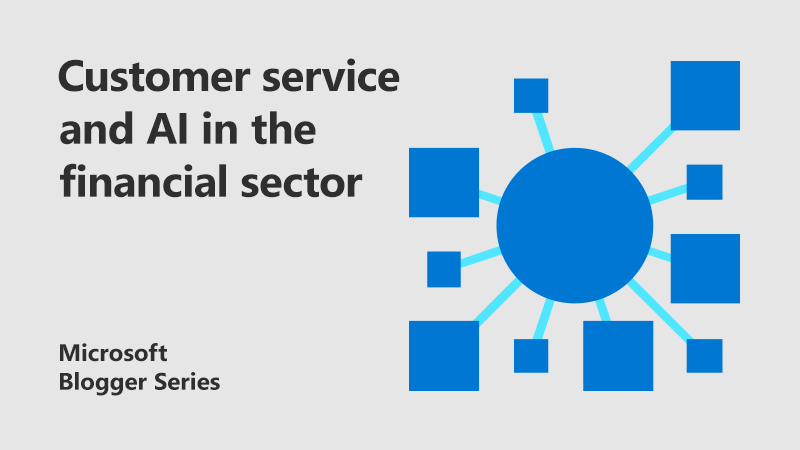
How companies use AI to deliver improved customer service in the financial sector
Today’s customers demand a higher level of service than ever before. As businesses have adjusted their services, expectations have increased. For organisations, this represents a balance act: how can you improve customer service, increase productivity and efficiency, without adversely impacting workloads?
Technology lies at the heart of this conundrum.
HSBC & AI: A use-case
In early 2019, HSBC UK Commercial Bank engaged Volume.ai, a Microsoft AI Partner specialising in conversational AI and natural language processing (NLP) technologies. The use-case focused on improving the productivity of Relationship Managers, Relationship Directors and other customer-facing team members. The aim was to reduce the time spent on necessary tasks, allowing staff to focus more of their time on delivering a superior customer experience.
One of the key requirements was to eliminate the need to write contact reports and reduce the manual tasks that were assigned to staff so they could focus on more strategic tasks. Volume was keen to leverage its experience in conversational AI and NLP and to utilise the latest Microsoft technologies in custom speech to text, language understanding, machine reading comprehension and neural voice. They were also keen to improve workflows and productivity by integrating with productivity tools like Microsoft Teams and Planner.
Volume came up with an innovative app called Memo. The original proof-of-concept has now evolved into a ‘Personal Assistant’, helping Relationship Managers and Relationship Directors easily prepare for meetings with customers and quickly retrieve important information about clients to aid their discussions.
How AI helps you help your customers
Your employees’ time can often be spent on writing up reports and other manual tasks that add to the workload. This, in turn, impacts customer service, with your team spending more time on administrative tasks than delivering the personalised and efficient service your customers have come to expect.
In the case of Memo, assuming a Relationship Manager takes approximately four to five client meetings per week – and that each post-meeting write-up takes approximately 30-45 minutes – that equates to a months’ worth of time saved each year per Relationship Manager. Leveraging Microsoft Custom Speech technology, the app converts a client meeting summary, dictated by the user, into text and audio files, so it can be stored and posted to Microsoft Teams, and referenced later. All tasks will be assigned to the right employee with the correct deadline. If the user indicates that a task is high priority, then the task is identified as such in Planner. Due to the sensitive nature of data, particularly in the financial sector, Memo includes a confidential mode. By activating this, any recorded meetings will be kept private, and not posted on Teams in the usual manner.
Making data-driven business decisions
Another core issue for business leaders is determining patterns and trends that inform your business decisions. Again, this has a major impact on the service you provide (and, by extension, the way customers and potential customers, perceive you).
For HSBC, the app’s speech recognition model is trained to anticipate a range of financial phrases such as ‘EDITDA’, ‘Amortization’, and ‘FX rates’, reducing error rates by up to 9.5%.
That means, just in one specific sector, the app…
- Improves productivity
- Improves customer experience by enabling efficient and automated follow-ups
- Increases the quality of the data in reports
- Identifies sector trends
Now, imagine what an AI-driven app could do for your customer service?
The future of customer service
As the app develops, historical notes, as well as external data sources, could be used to anticipate customer requirements and proactively engage users to make useful suggestions that delight customers. It also means customers won’t have to repeat the same information, over and over again, to different departments; the information is always at hand.
AI-driven technology makes it easier to visualise industry trends, enabling users to enter meetings equipped with the latest information impacting their customers.
So-called ‘team awareness’ is another factor. This allows AI to understand individual capacity and availability. If someone isn’t available on a particular day, an action will be assigned to someone else in the team. This eases the workload and service flow, ensuring organisations can deliver exceptional customer service, at all times.
Find out more
Discover how to implement AI in financial services
About the author
Simi Awokoya is a Cloud Solution Architect in the Microsoft UK ISV Recruit team and is aligned to the Financial Services & Insurance industry. She works on the recruitment and technical enablement of partners building solutions on Azure. Simi started her career as a software developer and technical analyst in investment banking, so innovation in the FSI sector has been a top-of-mind passion from day one. With the rise of AI adoption, the Microsoft partners she manages are paving the way for the next generation of strategic solutions on the cloud.




